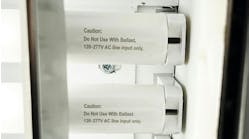Just a few years ago, TLEDs — the LED equivalents to linear fluorescent lamps — were somewhat of an iffy proposition in the lighting world. But their steadily improving performance and falling prices have made them competitive with conventional technologies, and they continue to pick up share in a market whose enormous size (an estimated 367 million installed troffers in the United States alone) offers tremendous scope for growth as well as for energy savings.
Linear fluorescent lamps (aka fluorescent tubes) are energy-efficient, long-lived, and relatively inexpensive, which is why they’ve been the dominant choice for ambient lighting in offices, classrooms, and other commercial spaces, where they’re typically housed in troffers, the ubiquitous 2×4, 2×2, or 1×4 luminaires installed in grid ceilings. Like fluorescent lamps, TLEDs are available in a wide range of color temperatures (predominantly 3,000K to 5,000K), have acceptable color fidelity (CRI > 80), last 50,000 hours, and are easy to install. Unlike fluorescent lamps, TLEDs don’t contain mercury, but their main selling point is energy savings. Although there is a wide range in performance, on average TLEDs draw about 60% of the power of linear fluorescents, creating the potential for significant energy savings if other tradeoffs are not problematic.
Potential savings
How can TLEDs save energy (and money) compared to their fluorescent counterparts? For starters, the system efficacy of a TLED and its driver is typically higher than that of a comparable fluorescent system (lamp + ballast). An average TLED today is around 115 lm/W, whereas linear fluorescent lamps are around 95 lm/W. However, trends indicate that the efficacy of TLEDs is increasing at about 8 lm/W to 10 lm/W per year in the short term, while fluorescent technology has stagnated. There are already some TLEDs exceeding 150 lm/W.
What’s more, the directional emission of TLEDs — in contrast to omnidirectional fluorescent tubes — typically enables the fixture to emit more useful lumens, with less waste, resulting in greater fixture efficiency. Combined, these attributes allow for lower connected wattage for TLEDs compared to fluorescent lamps. In retrofit applications, there is also an opportunity to save additional energy by lowering the light levels. Many existing spaces are overlit according to today’s best practices. This can sometimes be adjusted for by simply removing one or more of the existing lamps from a fixture, but the wide variety of TLEDs on the market may offer a more appropriate solution.
These savings don’t come without tradeoffs. The directional light distribution of TLEDs can help them deliver light more effectively, but can also change the appearance of the troffer in which they’re installed, because that fixture was designed to house fluorescent lamps. Moreover, the different distribution of light may cause the fixture’s optical system to perform differently, changing how the light is distributed in the room. For example, the walls may become darker. The best way to understand these tradeoffs is to conduct a mockup trial to evaluate performance before committing to an expensive installation.
Types of TLEDs
When considering TLEDs, it’s important to understand the different types of products that are available, and determine which one is best for the application (Table). There are four UL classifications for TLEDs:
• Replacement Lamps (UL Type A), which can operate off an existing fluorescent ballast and don’t require mechanical or electrical changes to the fixture. This type, which is “plug-and-play,” is becoming increasingly popular, but ballast compatibility varies, and there are efficiency losses due to the ballast. On the plus side, the installation cost and cost per lamp are low, installation is quick and easy, and this type of TLED doesn’t trigger building energy codes. On the other hand, re-using the existing ballast may mean that maintenance is required sooner.
• Internal Driver/Line Voltage Lamp-Style Retrofit Kits (UL Type B), which don’t operate off the existing fluorescent ballast and require rewiring of the existing fixture to bypass the ballast and send line voltage directly to the lamp holders. With this type, the sockets are powered by line voltage, the line-voltage sockets could prove dangerous for the installer, and there are still various wiring types. This type of TLED doesn’t allow for easy retrograde and can trigger code.
• Dual-Mode Internal Driver (UL Type A and Type B), which operate off the existing fluorescent ballast but also have the ability to operate on line voltage if the troffer is rewired to bypass the ballast
• External Driver Lamp-Style Retrofit Kits (UL Type C), which employ lamp holders to connect to the fixture being retrofitted, don’t operate off the existing fluorescent ballast, require rewiring of the existing fixture to replace the ballast with an external driver, and are wired to receive only the low-voltage electricity supplied by the external driver. With this type, the sockets — which are not necessarily standardized — are powered by low-voltage drive current.
The distinguishing features of the different types of TLEDs are very important during specification and installation, although there’s little difference in photometric performance.
Current barriers, dedicated troffers
Aside from the already strong performance of fluorescent lamps, a major challenge facing TLEDs is a lack of standardization. Given the variety of wiring configurations, there’s no guarantee that a lamp purchased five years from now will be wired the same way as the one you just installed, let alone have similar photometric performance. Unlike fluorescent lamps, there are no standard wattages or lumen packages with TLEDs. While the variety of TLED outputs and distributions can be used as an advantage, it can make comparing or replacing products more challenging, especially since the lamps’ distributions will interact with the optical system of the luminaire in which they are installed. Today, many manufacturers describe the beam angle of the lamp — a measure borrowed from directional lamps, such as PARs and MRs — but it provides little indication of how the lamp will work in a luminaire. A troffer carefully designed to sculpt the light of a fluorescent lamp may not work well with a TLED.
Another important consideration is that TLEDs aren’t just competing with fluorescent lamps; they’re also competing with other ways to incorporate LEDs into a grid ceiling, such as dedicated LED troffers and LED retrofit kits, which eschew the lamps and are designed ground-up for LEDs. While the raw efficacy of TLEDs exceeds that of dedicated LED troffers, the reverse is true if TLED efficacy is adjusted to account for luminaire efficiency. In other words, dedicated LED troffers tend to exceed the efficacy of troffers fitted with TLEDs. In a recent U.S. Department of Energy Snapshot report on TLEDs (see A Market Snapshot), in order to compare the efficacy of TLEDs to that of other LED luminaires, a multiplier of 0.8 was applied, representing a very efficient luminaire (i.e., 80% efficiency) in which a TLED might be operated. Even using that generous multiplier (many luminaires in which TLEDs are installed have an efficiency of 60%), the TLEDs tended to have lower efficacies than the dedicated LED luminaires against which they might compete.
What’s more, dedicated troffers optimize the overall lighting design to take maximal advantage of the characteristics of LEDs. They also provide the option of having integrated controls, eliminate the potential for retrograde, and often have a longer lifetime. These advantages are offset by a higher cost per luminaire and higher installation costs — as well as the likelihood of triggering building energy codes, which may require additional measures.
Installing and maintaining TLEDs
When contemplating the installation of TLEDs, it’s important to give thought to your long-term goals for the space, because with the lifetime of LED lighting products, some choices will commit you to a particular technology for a long time. It’s also advisable to consider a role for controls at the outset, because controls can significantly increase the energy savings, but as luminaire efficacy increases, it becomes less cost-effective to add them later on, which could result in a lost opportunity.
TLEDs are the most numerous type of product listed with LED Lighting Facts, so there are lots of options for finding the right product, but also lots to consider. While average efficacy is 20% to 30% higher than with typical fluorescent lamps, some TLEDs are less efficacious than linear fluorescent lamps, exemplifying the variety that characterizes all LED product types. That’s why it’s critical to thoroughly research each individual product in order to make an informed decision, weighing tradeoffs between cost and performance, energy savings and appearance, or color and efficacy, as appropriate.
The DesignLights Consortium’s Qualified Products List is a good resource to help you find products that have been tested and meet your performance goals. In addition, you might want to consider developing performance-based criteria for the specific application in question, and ask your vendor to deliver a system that meets your requirements (e.g., maintained light levels). Doing an honest life-cycle cost calculation to determine the total cost of ownership can put things into clear economic perspective, and a mockup is always a good idea.
As far as maintenance is concerned, when re-lamping it’s a good idea to double-check the manufacturer’s wiring configuration, as these can change, even within the same model number. (As always, it’s best to procure some spare stock at the time of installation.) Also, clear documentation needs to be provided at the outset, so that the correct lamp type and wiring can be purchased at the time of re-lamping, unless the new lamp will work in the existing wiring configuration. The risks of mis-lamping include short-circuiting the lamp holder and causing tube failure or socket damage.
The big picture
TLEDs on the whole are already more efficacious than their fluorescent counterparts, and their performance continues to improve, even as they begin to add other capabilities — such as color-tunability and enhanced controls. The potential for energy savings is enormous, when you consider that troffers account for more than 1% of all energy use in the U.S. Viable TLED options are increasingly available, something that could not be said a few years ago. As TLEDs push the efficacy limits for LED products, replacing low-cost fluorescent lamps becomes more compelling, as long as other tradeoffs are appropriately accounted for.
Brodrick is the lighting program manager for the U.S. Department of Energy, Building Technologies Office, Washington, D.C. He can be reached at [email protected].
SIDEBAR: A Market Snapshot
As far as maintenance is concerned, when re-lamping it’s a good idea to double-check the manufacturer’s wiring configuration, as these can change, even within the same model number. (As always, it’s best to procure some spare stock at the time of installation.) Also, clear documentation needs to be provided at the outset, so that the correct lamp type and wiring can be purchased at the time of re-lamping, unless the new lamp will work in the existing wiring configuration. The risks of mis-lamping include short-circuiting the lamp holder and causing tube failure or socket damage.
Last summer, the U.S. Department of Energy (DOE) published a Snapshot report on TLEDs. Because they’re based on the products listed with DOE’s LED Lighting Facts program, which showcases LED products for general illumination from manufacturers who commit to testing and reporting performance results according to industry standards, Snapshots provide a good indication of the current state of the market.
The Snapshot found that TLEDs are becoming increasing popular. As of June 2016, there were more than 4,500 TLED products listed with LED Lighting Facts — which was slightly more than 10% of all products listed at that time, and more than 50% of all listed lamps (Table A) (Note: LED Lighting Facts stopped listing lamps in December 2016). However, when it comes to performance, TLEDs are not necessarily a clear favorite. The data showed that TLEDs consistently draw less power and emit fewer lumens than their fluorescent counterparts. While they have somewhat higher efficacies, the resulting energy savings are due in large part to the lower power draw.
Significantly, the emission of TLEDs is almost always more directional than that of linear fluorescent lamps, which means that TLEDs can make luminaires more efficient by using fewer lamp lumens to deliver equal illuminance to the work plane. But the increased luminaire efficiency can’t always compensate for the reduced lamp lumens, in which case the energy savings come from reducing the light levels, which may not be acceptable. While the change in distribution from TLEDs isn’t obvious from the LED Lighting Facts data, it can change not only the appearance of the luminaire, but also the distribution of light within a space. For example, walls may be darkened.
At first glance, TLEDs — with their higher efficacy and usually lower product and installation costs — may seem superior to the other LED options, such as retrofit kits or dedicated LED fixtures, for replacing a fluorescent lighting system. But in some situations, such factors as luminaire efficiency can tip the balance against TLEDs, whose long-term costs may also be increased by factoring in the remaining life of existing fluorescent ballasts, if they’re to be reused.
Still, viable TLED options are increasing in number, and the argument for using them to replace fluorescent tubes can be compelling, if other tradeoffs are taken into consideration. But there are thousands of TLEDs to choose from, and as the Snapshot shows, there’s considerable variation in the performance. When evaluating TLEDs, it’s important to look at the expected performance of the complete lamp and luminaire system, understand the complexities of installation, and be conservative in considering long-term performance.






